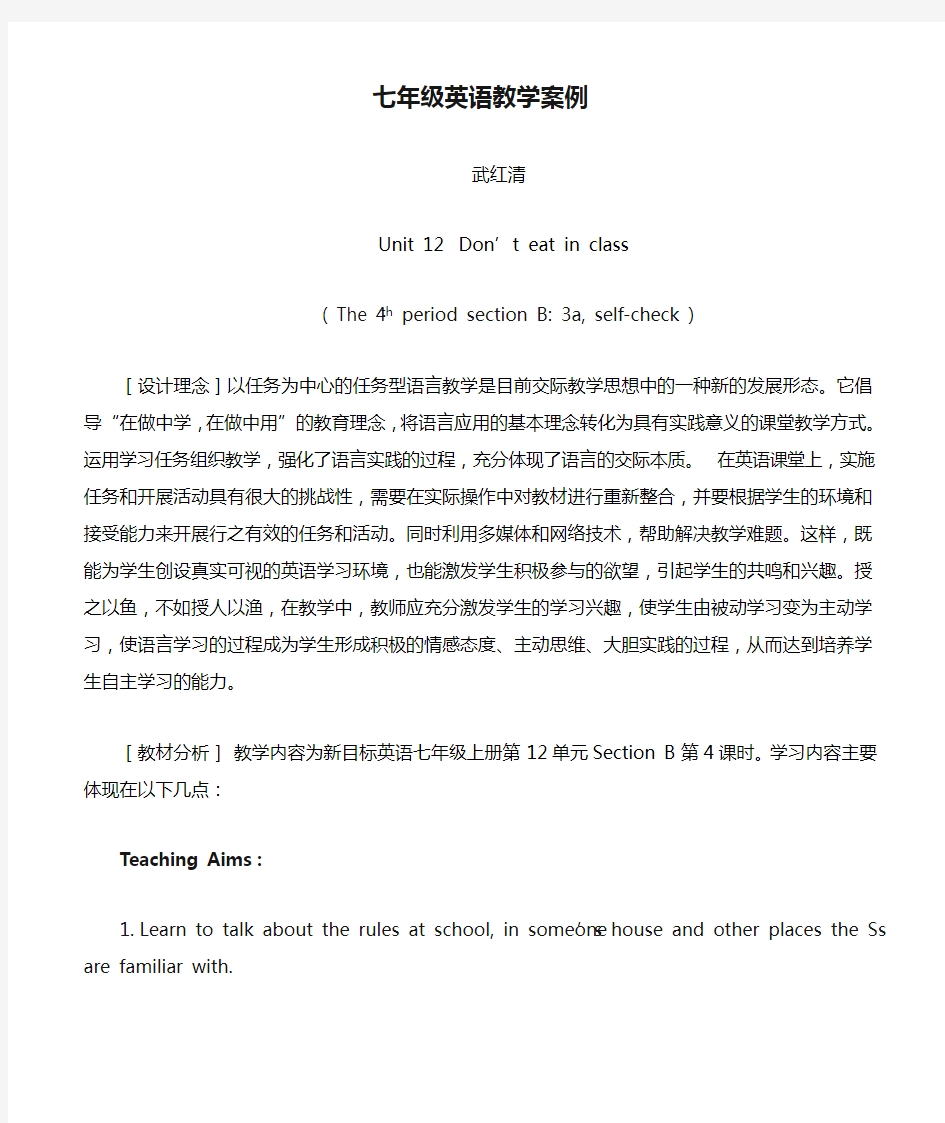七年级英语教学案例

- 1、下载文档前请自行甄别文档内容的完整性,平台不提供额外的编辑、内容补充、找答案等附加服务。
- 2、"仅部分预览"的文档,不可在线预览部分如存在完整性等问题,可反馈申请退款(可完整预览的文档不适用该条件!)。
- 3、如文档侵犯您的权益,请联系客服反馈,我们会尽快为您处理(人工客服工作时间:9:00-18:30)。
七年级英语教学案例
武红清
Unit 12 Don’t eat in class
( The 4th period section B: 3a, self-check )
[设计理念]以任务为中心的任务型语言教学是目前交际教学思想中的一种新的发展形态。它倡导“在做中学,在做中用”的教育理念,将语言应用的基本理念转化为具有实践意义的课堂教学方式。运用学习任务组织教学,强化了语言实践的过程,充分体现了语言的交际本质。在英语课堂上,实施任务和开展活动具有很大的挑战性,需要在实际操作中对教材进行重新整合,并要根据学生的环境和接受能力来开展行之有效的任务和活动。同时利用多媒体和网络技术,帮助解决教学难题。这样,既能为学生创设真实可视的英语学习环境,也能激发学生积极参与的欲望,引起学生的共鸣和兴趣。授之以鱼,不如授人以渔,在教学中,教师应充分激发学生的学习兴趣,使学生由被动学习变为主动学习,使语言学习的过程成为学生形成积极的情感态度、主动思维、大胆实践的过程,从而达到培养学生自主学习的能力。
[教材分析]教学内容为新目标英语七年级上册第12单元Section B 第4课时。学习内容主要体现在以下几点:
Teaching Aims:
1.Learn to talk about the rules at school, in someone’s house and other places the Ss are familiar with.
2.Learn to use “I have to …”, “I can / can’t …”, “Don’t…”to describe the rules of each place.
3.Learn to be a polite student anywhere.
Important Points and Difficult Points:
1.Master the sentence structure “No+doing” , “No+noun”
2.祈使句肯定形式与否定形式的运用。
3.Describe the rules of the places correctly and fluently.
[学生分析]
1、利用多媒体课件上英语课,学生视听感受明显,表现出极大兴趣,在欣赏和享受中学习,学习效果很明显。
2、话题来源于学生的实际生活,使得学生有话可说,知无不言,言无不尽。
[教学目标]
1、谈论学生感兴趣的话题,话题的展开有利于规范学生的日常行为,适时的进行了人格教育。。
2、通过学习本课,增强师生、生生间的相互了解和沟通。
3、培养学生的口头表达能力、阅读理解能力和写作能力。
[教学过程]
Step 1 Warming-up and Lead-in
Sing an English song with lyrics in the screen.
T:Class, do you like music? Let’s sing an English song together.
[1、由于是借班上课,老师与学生之间不是很熟悉,学唱一首轻松活泼的英文歌曲,能够使学生快速进入英语课堂,调动学生的学习兴趣;2、英语歌曲的歌词比较多,学生第一次学唱这首歌,难度有点大,如果先chant歌词,再sing 歌曲,学生是不是会更容易接受。]Step 2 Competition
1. The teacher tells the students about the instruction for a game.
T: We have two groups, A and B, We’ll have a c ompetition between A and B,Let’s see which group will answer the most questions?
2. Play a video of a movie, T: What rules are they breaking? If they are your classmates, what will you say to them?
Ss: Don’t play cards in class
Don’t smoke
[1、设置转化期,通过观看《逃学威龙》的影片片段,复习已学内容,自然延伸到新课学习;2、开展竞赛活动,既可调动课堂气氛,又可提高求知欲望,一举两得。]
3. T: What are the rules in the library?
Ss: Don’t …
We have to …
We can’t …
(Get more participation from the students)
[Don’t …句型的到了很好的复习与操练,值得探讨的是此环节是否可以自然的把Do…句型跟Don’t …句型放在一起操练,从而对祈使句的肯定形式与否定形式进行了巩固。]
4. T: Do you know these signs? Get them to identify the public signs, the public sign recognitions help them to learn the model No doing / No + noun.
[设计公共场所图片要求学生辨认,使目标语言激活]
Step 3 Presentation
Present a reading test for the students in the form of a letter. The students are asked to underline the parts which are the rules for them.
The teacher checks the results of the students.
Then the whole class read all the rules loudly.
Step 4 Listening to the tape
[听力训练既是对知识的巩固,也为下一步的任务输出提供了输入材料。在听之前教师应该先明确要求,例如模仿人物的语音语调,act like Zhao Pei. ]
Step 5 A role play
T:If you are Zhao Pei, What will you say to your parents to make them understand you? Let’s act it out. Three students in a group act as father, mother and Zhao Pei,make a short play.
[1、设计的活动既突出互动合作,又体现个性化发展,有利于调动各个层面同学的学习积极性,最大限度地提高每位同学的参与意识。2、活动的主题难易顾及到学生的实际情况,操作具有可行性。3、教师导演,学生主演,充分发挥学生的主体作用和积极能动性。4、完全改变了以往“直截了当向学生传授语言”的传统教育模式,真正体现了“以人为本”的任
